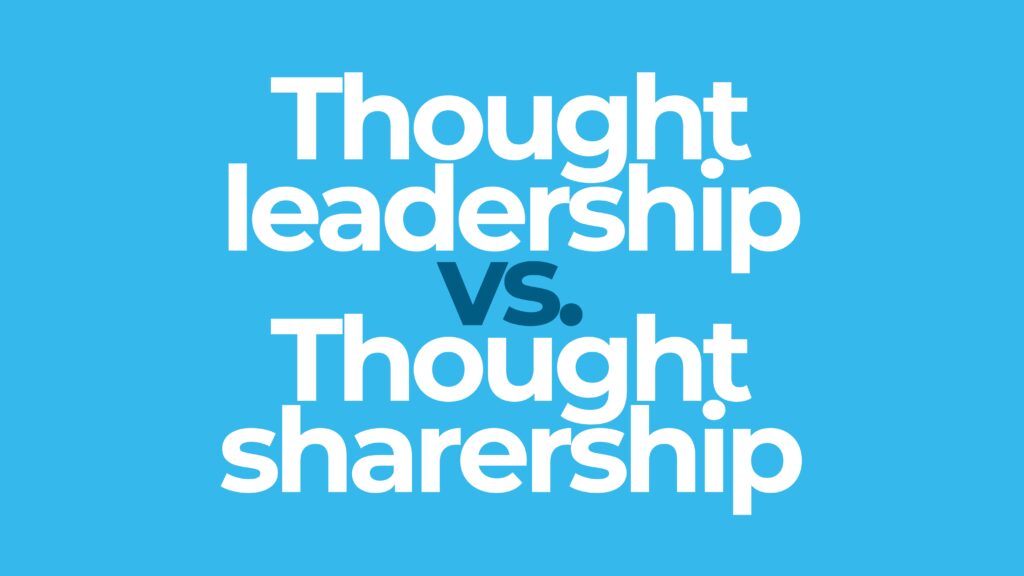The term “thought leadership” was coined in 1994 by Strategy and Business magazine’s then editor-in-chief Joel Kurtzman. “Thought Leaders,” he said, “possess a distinctively original idea, a unique point of view or an unprecedented insight into their industry.”
Most people who are serious about their work would be interested in a thought leadership piece with one or more of these qualities.
- Original ideas are exciting. The best ones buckle your knees with their brilliance.
- Unique points of view are challenging. The really well-presented ones can have you changing a previously unchangeable position.
- Unprecedented insights are thought-provoking. The smartest ones impact the way you do business.
But for the thought leadership piece to really hit home, we believe it needs one quality above else.
Your thought leadership needs to be actionable.
This is what separates leading with thoughts versus sharing your thoughts.
We want to put what we learn to use right away because we’re not consuming thought leadershipcontent for our own health.
We consume thought leadership content to give ourselves an edge in our careers. We want tips for success we can implement now. We want suggestions for growth and what seeds to plant now. We want knowledge we can leverage. And we want to know how.
Generally speaking, three criteria have to be met to achieve actionability in thought leadership content:

Easy to understand.
Strong thought leadership content isn’t packed with jargon or filler. It simply lays out the premise or problem. It introduces its original idea, unique point of view or unprecedented insight. It outlines how to implement the solution. And explains the expected results.
Focused on one problem or premise.
Strong thought leadership content doesn’t try to overload. It’s not a PhD thesis. It’s a teaching tool. And overwhelming a student is an excellent way to stall their learning.
Crafted from the enactment point backwards.
Enactment is an interesting concept we learned about recently as part of a job for another client. Research conducted at the University of Waterloo showed that incorporating physical action (a.k.a., enactment point) into a knowledge transfer effort improves internalization speed and retention.
In other words, we all learn by doing.
Let’s build an enactment point into this thought leadership effort.
We offer a solution called Hooklines. At the end of the Hooklines process, our clients have the best version of their story. And it’s the best version of their story because it positions them as the hero of their prospect’s story.
An easy indicator of how far off a company is from the best version of their story (and how much they could benefit from Hooklines) is a simple “we count.” This is literally counting the number of times “we” (or “I”) appears on your company’s home page. If it’s one or more, you don’t have the best version of your story.
The “we count” is the enactment point of this thought leadership piece.
Go over to your website and do your “we count” now.
No “we” or “I.”
Good news! You’re probably close to the best version of your story because the absence of “we” or “I” leaves more room for “you” statements (“you’ll feel…,” “you’ll be…,” “you’ll find…,” “you’ll win…”).
Ideally, you’ll have taken advantage of the extra real estate to explain why and how your ideal prospect’s life will be better tomorrow if they choose you today.
A bit of “we” or “I.”
Hey…you’re human. Some are going to slip through. But be careful.
“We” and “I” statements are the easiest (and laziest) ways to communicate because they’re the path of least resistance: you know your story better than any other story.
Without attention, we’s and I’s tend to multiply quickly. And if you’ve ever sat next to someone at a dinner party who goes on and on about themselves, you know you didn’t want to sit there very long.
Lots of “we” or “I.”
You probably wonder why so much of the traffic to your website isn’t converting. And if you spend money generating that traffic, you probably wonder why your investment is being wasted.
Too much “I” or “we” could be the answer.
When your story centres you instead of the prospect you’re looking to convert, your prospect has no idea why to stay engaged. They don’t care about you, your experience, your accomplishments or your price. Yet.
They care about themselves, their problem and how quickly it can get fixed.
Centring that (and them) is a much better way to hook them into what you’re offering.
Once your prospect understands how you’re going to make their lives better, they’ll eat up anything you want to tell them about you. They’ll share it far and wide. And they’ll become your best sales people.
Now what?
If you’re an established thought leader or just new to thought leadership, consider building enactment points into your thought leadership efforts. Your ideas will be internalized more completely and retained more effortlessly. And when the time comes to make a decision, your ideal client will remember what they did far more clearly that what they read.
